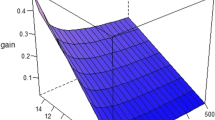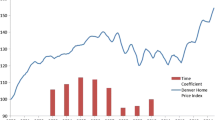Abstract
This research reports results from a competition on modeling spatial and temporal components of house prices. A large, well-documented database was prepared and made available to anyone wishing to join the competition. To prevent data snooping, out-of-sample observations were withheld; they were deposited with one individual who did not enter the competition, but had the responsibility of calculating out-of-sample statistics for results submitted by the others. The competition turned into a cooperative effort, resulting in enhancements to previous methods including: a localized version of Dubin’s kriging model, a kriging version of Clapp’s local regression model, and a local application of Case’s earlier work on dividing a geographic housing market into districts. The results indicate the importance of nearest neighbor transactions for out-of-sample predictions: spatial trend analysis and census tract variables do not perform nearly as well as neighboring residuals.
Similar content being viewed by others
References
Case, B. (2000). "Co-Movements in International Commercial Real Estate Markets," Working paper, Federal Reserve Bank (August 2000).
Case, B. (2001). "Co-Movements in U.S. House Price Appreciation Patterns," Working paper, Federal Reserve Bank (January 2001).
Case, B. (2002). "Homogeneous Within-County Districts for Hedonic Price Modeling," Working paper, Federal Reserve Bank (May 2002).
Clapp, J. M. (2002). "A Simi Parametric Method for Estimating Local House Price Indices," Draft paper, University of Connecticut Center for Real Estate. Available at: http://www.sba.uconn.edu/users/johnc/currentresearch.html
Clapp, J. M., and C. Giaccotto. (1998). "Residential Hedonic Models: A Rational Expectations Approach to Age Effects," Journal of Urban Economics 44, 415-437.
Clapp, J. M., H.-J. Kim, and A. E. Gelfand. (2002). "Spatial Prediction of House Prices Using LPR and Bayesian Smoothing," Real Estate Economics 30(4), 505-532.
Dubin, R. (1992). "Spatial Autocorrelation and Neighborhood Quality," Regional Science and Urban Economics 22, 433-452.
Dubin, R., R. K. Pace, and T. G. Thibodeau. (1999). "Spatial Autoregression Techniques for Real Estate Data," Journal of Real Estate Literature 7, 79-95.
Fan, J., and I. Gijbels. (1996). Local Polynomial Modeling and Its Applications. New York: Chapman and Hall.
Goetzmann, W. N., and M. Spiegel. (1997). "A Spatial Model of Housing Returns and Neighborhood Substitutability," Journal of Real Estate Finance and Economics 14(1), 11-31.
Goldberger, A. S. (1968). "The Interpretation and Estimation of Cobb-Douglas Functions," Econometrica 36, 464-472.
Goodman, A. C., and T. Thibodeau. (1995). "Age Related Heteroskedasticity in Hedonic House Price Equations," Journal of Housing Research 6(1), 25-42.
Hu, D. (1999). "A Semiparametric Investigation of Lower-Income Home Mortgage Purchases in the Secondary Mortgage Market," Draft Paper, Zell/Lurie Real Estate Center, The Wharton School, University of Pennsylvania.
McMillen, D. P. (1994). "Vintage Growth and Population Density: An Empirical Investigation," Journal of Urban Economics 36, 333-352.
Miller, D. M. (1983). "Reducing Transformation Bias in Curve Fitting," Virginia Commonwealth University, Institute of Statistics Working Paper No. 7, November 1983.
Neyman, J., and E. L. Scott. (1960). "Correction for Bias Introduced by a Transformation of Variables," Annals of Mathematical Statistics 31, 643-655.
Pace, R. K., R. Barry, J. M. Clapp, and M. Rodriguez. (1998a). "Spatial Autoregressive Models Neighborhood Effects," Journal of Real Estate Finance and Economics 17, 15-33.
Pace, R. K., R. Barry, and C. F. Sirmans. (1998b). "Spatial Statistics and Real Estate," Journal of Real Estate Finance and Economics 17, 1-13.
Pace, R. K., C. F. Sirmans, and C. Slawson. (2002). "Are Appraisers Statisticians?" In Real Estate Valuation Theory, Research Issues in Real Estate Monograph Series, Vol. 8, American Real Estate Society, Dordrecht: Kluwer Academic Press.
Pfeifer, P. E., and S. Bodily. (1990). "A Test for Space-Time ARMA Modeling and Forecasting of Hotel Data," Journal of Forecasting 9, 255-272.
Ripley, B. (1981). Spatial Statistics. New York: Wiley, pp. 45-51.
Robinson, P. M. (1988). "Root-N-Consistent Semiparametric Regression," Econometrica 56, 931-954.
Raman, P. (2002), "Towards Robust House Price Index Estimation: An Empirical Investigation of San Diego, California," Draft paper, Fannie Mae.
Stock, J. H. (1989). "Nonparametric Policy Analysis," Journal of the American Statistical Association 84, 567-575.
Thibodeau, T. G. (1989). "Housing Price Indexes from the 1974-1983 SIMSA Annual Housing Surveys," AREUEA Journal 1, 100-117.
Wand, M. P., and M. C. Jones. (1995). Kernel Smoothing New York: Chapman and Hall.
Yatchew, A. (1998). "Nonparametric Regression Techniques in Economics," Journal of Economic Literature 36, 669-721.
Author information
Authors and Affiliations
Rights and permissions
About this article
Cite this article
Case, B., Clapp, J., Dubin, R. et al. Modeling Spatial and Temporal House Price Patterns: A Comparison of Four Models. The Journal of Real Estate Finance and Economics 29, 167–191 (2004). https://doi.org/10.1023/B:REAL.0000035309.60607.53
Issue Date:
DOI: https://doi.org/10.1023/B:REAL.0000035309.60607.53




